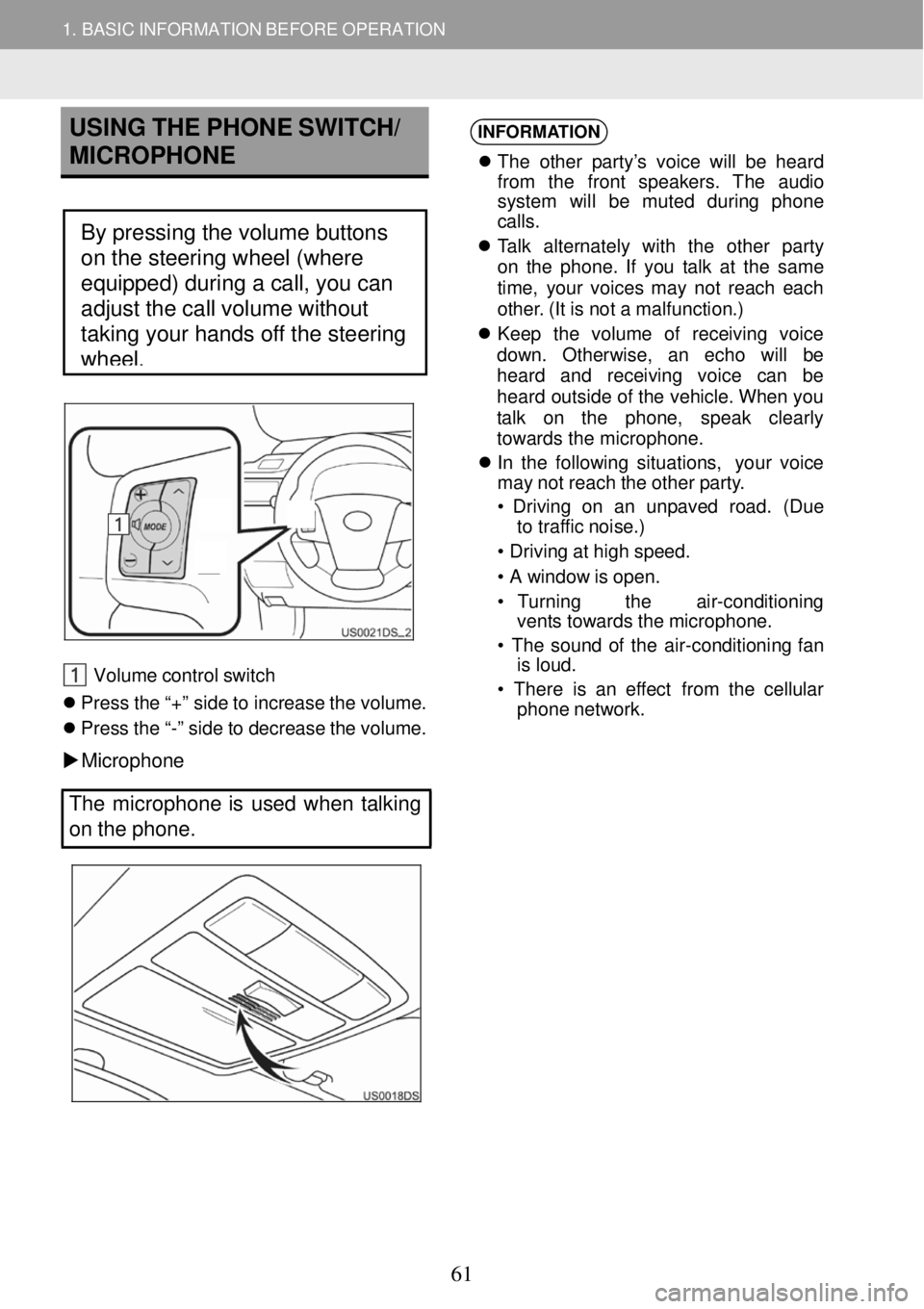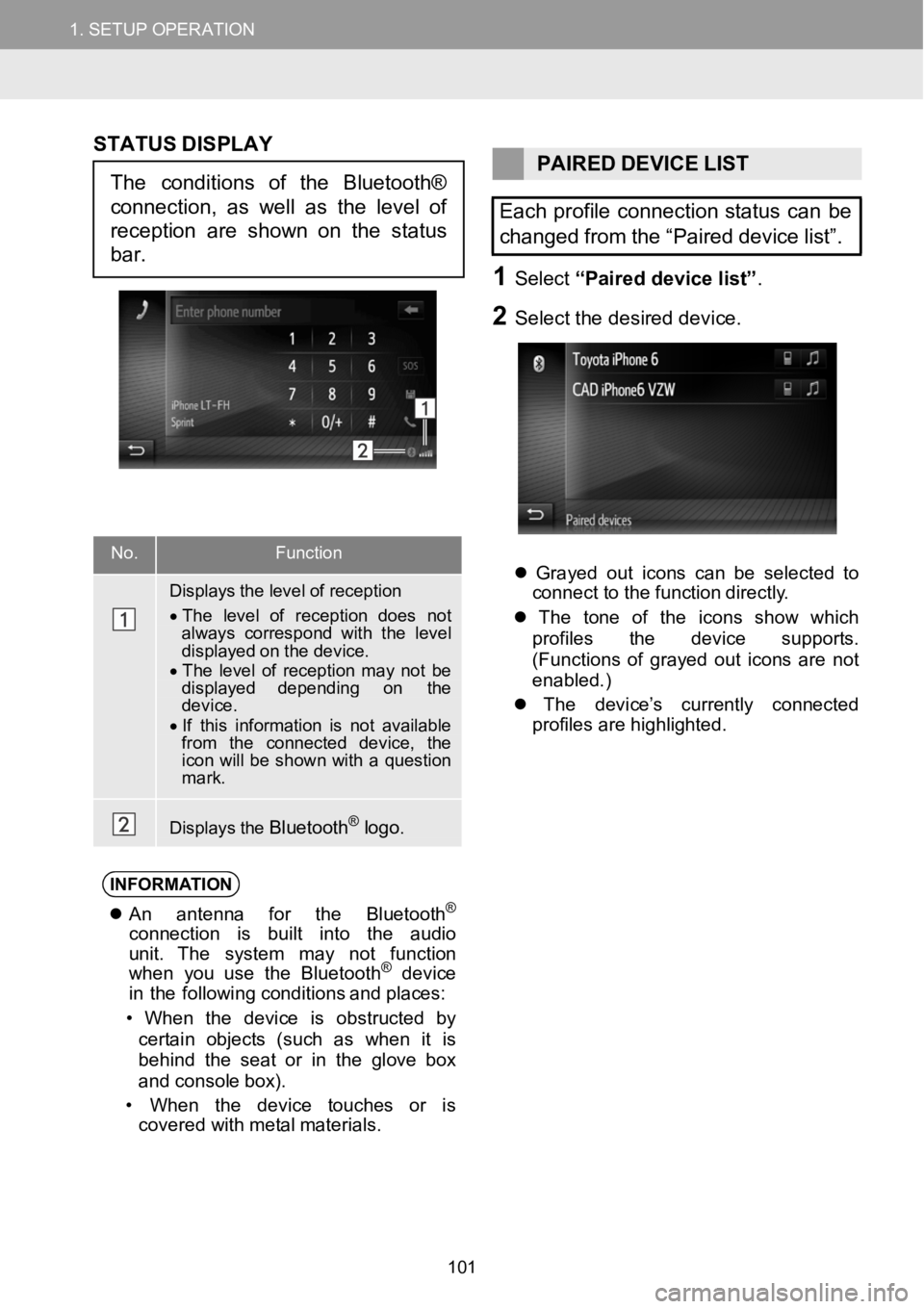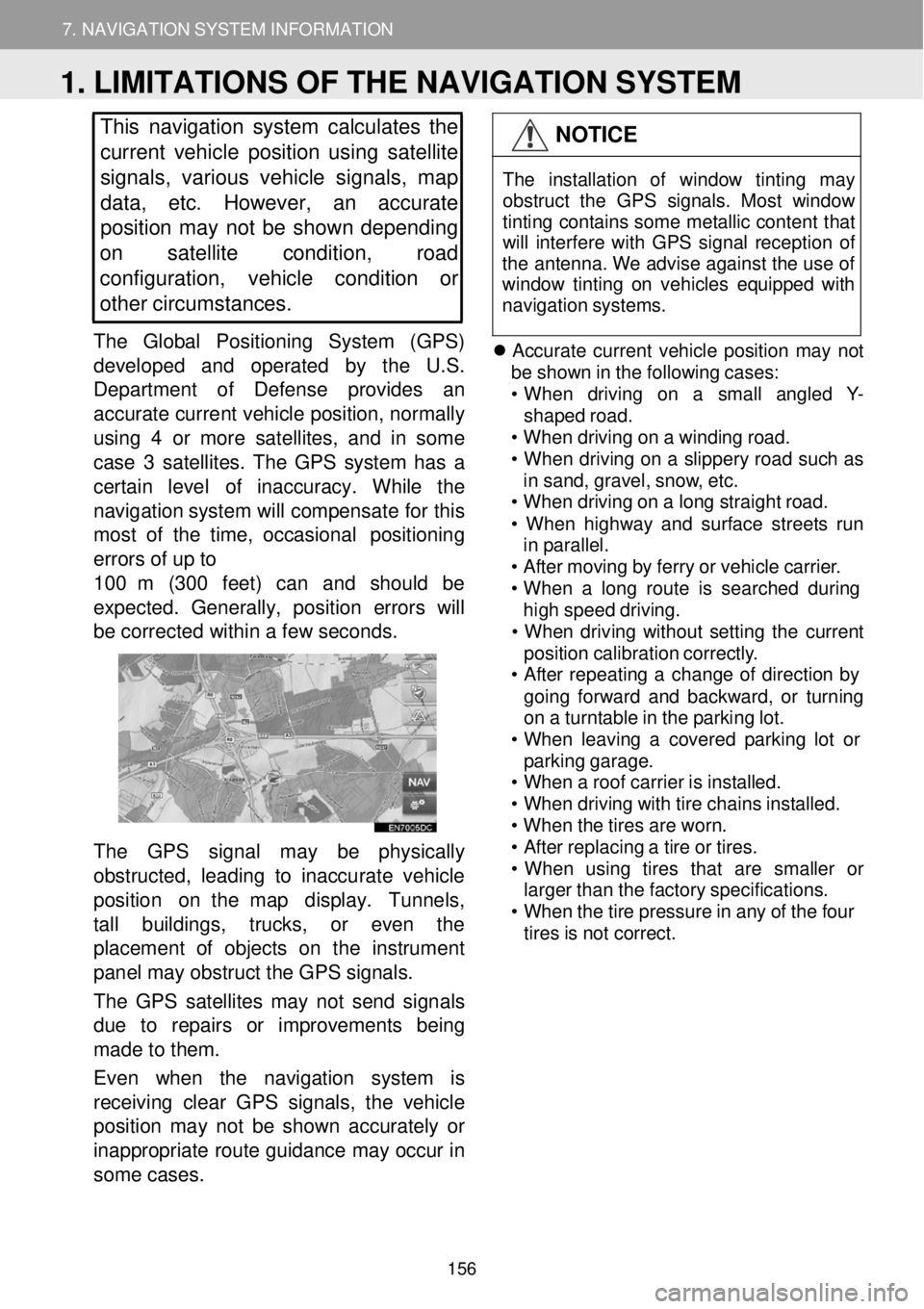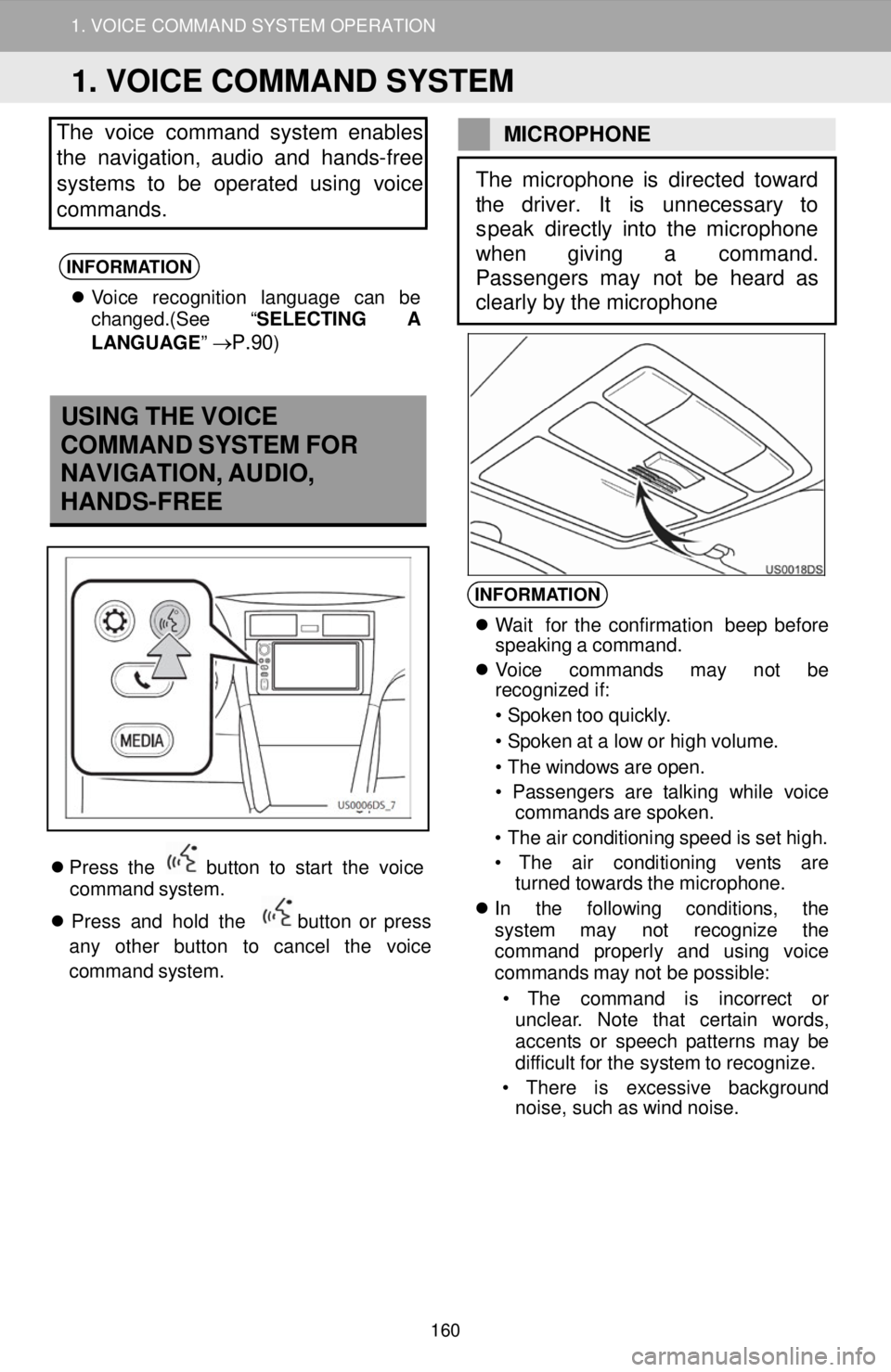air condition TOYOTA COROLLA iM 2018 Accessories, Audio & Navigation (in English)
[x] Cancel search | Manufacturer: TOYOTA, Model Year: 2018, Model line: COROLLA iM, Model: TOYOTA COROLLA iM 2018Pages: 164, PDF Size: 8.51 MB
Page 61 of 164

1. BASIC INFORMATION BEFORE OPERATION
USING THE PHONE SWITCH/
MICROPHO NE
Steeri ng switch (IF EQUIPPED)
Volum e control sw itch
Pr ess the “+ ” side to i ncrease the vo lume.
Press the “-” side to decrease the volume.
Microph one
INFORMA
TION
Th e othe r par ty’s voice will be h eard
fro m the front speak ers. Th e audio
sys tem will be muted during phon e
c al ls.
Ta lk a lternately with the ot her p arty
on the phone . If you t alk at the same
t im e, yo ur voices may not re ach each
ot her. ( It is not a malfunct ion.)
Kee p the volume o f rece iving voice
down. Otherw ise, an echo will be
h eard and rece iving voice can be
he ard o utside of the vehicle. When you
ta lk on t he phone, speak cl early
towards the micro phone.
In th e f o
l lowing situ ations, your vo ice
ma y not reach the ot her party.
• Dr iving on an unpaved road. (Due
to tra ffic noise.)
• Dr ivi ng a t high speed.
• A window is open.
• Turnin g the air-conditioni ng
vents towards the mi crophone.
• Th e sound of the a ir-conditio ning fan
is loud.
• Ther e is an effect from the cellular
phone n etwork.
The micropho ne is used when talking
on the phone.
By pressing the volume buttons
on the steering wheel (where
equipped) during a call, you can
adjust the call volume without
taking your hands off the steering
wheel.
61
Page 101 of 164

1.SETUPOPERATION1.SETUPOPERATION
No.Functi on
Displays the level of reception
•The level of reception does notalways correspond with thelevel displayed on the device.•The level of reception m aynot be displayed depending on thedevice.•If this information isnot available from the connected device, the icon willbe shown witha question mark.
Displays theBluetooth®logo.
STAT US DISPLAY
PAIREDDEVICELIST
Each profile connection status canbe
changed from the “Paired devicelist”.
1Select“Paired device list ”.
2Se lect the d esired d evice.
Grayed out icons can be selected to
c onne ct to the f unction dire ctly.
The tone of the icons show which
pro files the d evice su pports.
( Functions of grayed out icons are not
enabled.)
The de vice’s cu rrently connec ted
pro files ar e highlig hted.
INFORMA TION
An ant enna for the Bluet ooth®
conn ect ion is built into the audio
unit . Th esystem may not funct ion
when youuse the Bluet ooth
®device
in the f ollowin g conditions and p laces:
• When the dev ice is obstructed by
cer tai n objects (such as when it is
beh ind the seat or in the g love box
and conso lebo x).
• When the device t ouches or is
covered with me talma terials.
Theconditions of theBluetooth®
connection, as well as the level of
reception are shownon the status
bar.
101
Page 156 of 164

7. NAVIGATION SYSTEM INFORMATION
1. LIMITATIONS OF THE NAVIGATION SYSTEM
7. NAVIGATION SYSTEM INFORMATION
This navigation system calculates the
cu rrent vehicle position using satellite
s ignals, various vehicle signals, map
data, etc. However, an accurate
positi on may not be shown depending
on satellite condition, road
configuration, vehicle condition or
other circumstances.
The Gl obal Pos iti onin g System (GPS)
deve loped and op erated by the U.S.
Departme nt o f D efense prov ides an
a ccurate current vehicle pos ition, normal ly
using 4 or more sate llites, and in some
case 3 satellites. The GPS system has a
certain level of inaccuracy. While the
navi gation system w ill compe nsate for this
most of th e time, occasion al po sitioning
errors of up to
1 00 m (300 feet) can and shou ld be
ex pe cted. Gen erally, p osit ion errors w ill
b e c orrected w ith in a few seconds.
The GPS signal may be physic ally
ob structed, l ead ing to inaccura te veh icle
posi tion on t he map d isplay. Tunne ls,
ta ll buil dings, trucks, or even the
p lacement of obje cts on the instrume nt
pan el may obstruct the GPS signals.
Th e GPS satel lites may not send sign als
du e to r epairs or improvemen ts be ing
ma de to them.
Even when the navigation system is
rece iving clear GPS si gnals, the v ehicle
po sition ma y not be shown accurately or
i na ppr opri ate route guidance may occur in
som e cases.
NOTICE
The ins tallat ion of wi ndow tint ing may
obstr uct the GPS s ignals . Mos t window
tinting co ntains som e me tallic cont ent that
w ill int erfere with GP S si gnal re ception of
the antenna . We advise agai nst the use of
win dow ti nting on vehicles eq uip ped w ith
n avi gation s ystems.
Accurate current ve hicle position may no t
be sh own in the following cases:
• When drivin g o n a smal l a ngled Y-
shap ed ro ad.
• When driving on a wi nding road.
• When driving on a sli ppery ro ad such as
in sand, gravel , snow, et c.
• When driving on a long s traight ro ad.
• When highway and surf ace streets run
in p arallel.
• After moving by ferry or vehi cle carri er.
• When a long route is searc hed during
hi gh speed drivi ng.
• Whe n driv ing wi thout setting the cu rrent
position ca librat ion co rrectly.
• After re peating a change of di rection by
going for
war d and backward, or t urning
on a turntable in the park ing lo t.
• When leaving a co vered parking lot or
p ark ing garage.
• When a roof carrie r is instal led.
• When driving w ith tir e cha ins i nst alled.
• When the t ires ar e wor n.
• After replacing a tire or t ires.
• Whe n us ing tire s tha t ar e sma lle r or
larg er than the fa ctory sp ecifi catio ns.
• When the tire pressur e in any of the f our
ti res is not corre ct.
1. LIMITATIONS OF THE NAVIGATION SYSTEM
156
Page 160 of 164

1. VOICE COMMAND SYSTEM OPERATION
The voice command system enables
the nav igation, audio and hands -free
systems to be operated us ing voice
commands.
INFORMATION
Voice recognitio n l angu age can be
change d.(See “ SELECTING A
LAN GUAGE ”
→P.90)
MIC ROP HONE
USING THE VOICE
COMMAND SYSTEM FOR
NAVIGATION, AUDIO,
HANDS-FREE
PTT (Push -To-Talk) button
Pres s the button to sta rt the v oice
comman d system.
Pres s and ho ld the
button or press
any other button to cancel th e voice
co mman d system.
INFORMA TION
Wa it fo r the co nfirmat ion beep b efore
speak ing a co mmand.
Voice commands may not be
re cogn ized i f:
• Spoken too quick ly.
• Spoken at a low o r hig h vo lume.
• The wi ndows are op en.
• Passen gers are talking while voice
comm ands are spo ken.
• The air conditio ning speed is set h igh.
• The air conditioning vents are
t urned towards the microph one.
In the following conditio ns, the
syst em may not re cognize the
comm and properly and using voice
co mmand s may not be possible:
• T he co mma
nd is i ncorrect or
unc lea r. No te that certai n words,
accent s or spe ech pat terns ma y be
diff icult fo r the sy ste m to re cogni ze.
• T here is ex cessive background
noi se, such as wind noise.
The microphone is directed toward
the driver. It is unnecessary to
s peak directly into the microphone
wh en giving a command.
Passengers may not be heard as
clearly by the microphone
1. VOICE COMMAND SYSTEM
160